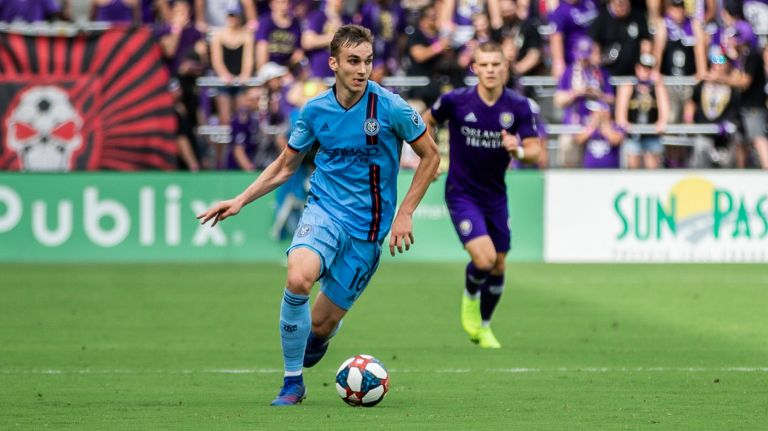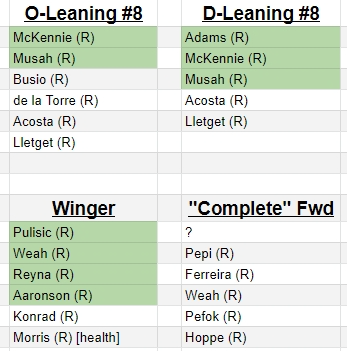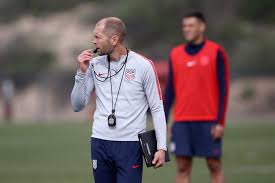
As a fan base, US Soccer fans do a pretty dang good job of knowing who the prospects are. We also love to hype them up/be excited about their potential. Some people don’t care for that and want everyone to be calm so we don’t thrust too much on these kids, too quickly. Forget that. LeBron was on the cover of SI at 16 and he’s done okay.
James Sands though, is one of those rare, young American players that has more or less flown under the radar. He’s a 20 year old center back/defensive midfielder for NYCFC that already has over 2,000 professional minutes. And strangely, he’s not gotten much attention from national team coaches or fans in the past couple of years. (He did play extensively for the U17 team back in 2017.)
Why did the call ups stop? The U20 team from 2019 was shallow at center back, but Tab Ramos preferred the trio of Chris Richards (understandable), Mark McKenzie (wasn’t healthy at the time, so a bit iffy), and Aboubacar Keita (only makes sense if being left footed was high priority).
Sands started all three games in the group stage of the MLS tournament and I watched all three while focusing only on Sands. Here are my conclusions after these viewings.
Strengths
Game Understanding
Occasionally, while watching an American football game, the commentators will make a big deal out of a player that knows not only his responsibilities during a play, but all of his teammates’ responsibilities as well. This is James Sands. He knows where he’s supposed to be, but he also knows where his teammates and opponents are as well.
This shows up in a couple different ways. One, is that he is constantly telling his teammates where the ball should go. He knows where the spaces are and communicates that info to his team.

Another demonstration of his awareness is how often Sands was in the correct spot to interrupt an attack or counter. Sands anticipates where the next pass is going to be and gets in position to break it up even though he’s not the quickest guy in the world.





Specific Flexibility
One of the problems for Weston McKennie in his young career has been his versatility. Need a fullback? He can do that. Center back? Sure. Target striker? Why not? It has led to McKennie not getting a run of games in his best position (#8) and growing there.
Sands on the other hand is specifically flexible, which I think is different and better for him. In the three MLS is Back tournament games Sands started at center back once, at d-mid once, and switched from center back to d-mid in the middle of the other one. The way that Sands can seamlessly switch back and forth between the two is a nice feature for a coach. If you want to adjust to three at the back in the middle of the half you don’t need to make any substitutions to accommodate that.
NYCFC was getting killed by Orlando. They had given up two goals in the first ten minutes and it wasn’t looking good. During the first half water break Ronny Deila moved Sands from center back to defensive midfield and the game evened out. From that point on, the game finished 1-1 with the last Orlando goal not coming until the 81st minute. This sort of tactical flexibility gives managers an interesting chess piece.


Room to Improve
Progressing the Ball
Maybe it’s because I have ball-playing CBs on the brain from a recent article, but I didn’t see Sands do much to get the ball forward. He doesn’t carry it forward on the dribble and he doesn’t split lines with his passing.
He’s safe and he rarely turns it over, but he doesn’t unbalance the defense from center back or defensive midfield. I’m not sure if that’s what Deila and NYCFC are asking him to do or if it’s his natural inclination, but it’s what I observed in these games.



Athleticism
I hate criticizing this because I feel like one of those “typical Americans” that want big, fast guys. Is it wrong to want players like Paul Pogba or Dayot Upamecano though?
Anyway, Sands isn’t going to win a lot of foot races. In the current USMNT setup the right center back is a defensive eraser. Aaron Long or Miles Robinson run Pizarro down in the clip below. Sands couldn’t keep up.

Most of the time it’s not a problem because he makes up for it in other ways, but you’re not going to see towering headers or impressive recoveries from Sands.
Prospects with the US?
I think Sands is in the conversation for the Olympic team. I don’t know who’ll be available (Richards, McKenzie, Otasowie, etc) but I would think he’d have a reasonable shot at a spot on that team.
I thought he was better at defensive mid than center back for NYCFC, and unless he improves his ball progression, I don’t see him as an option for the full USMNT as a center back (assuming the current profile remains).
Defensive midfield might be more possible though. If you’ve paid attention lately there’s a theory floating around that the USMNT could line up more like this in possession in the future:

He’d still have to improve and beat out a lot of other candidates (Yueill, Bradley, Cardoso, etc.), but that profile looks like it fits Sands like a glove. However you slice it, Sands is a useful player to have in the pool. The more good pros you have available the better players have to be to make the national team. That’s a good thing.
If you enjoyed this and would like to be informed of future articles type your email address in the box and you’ll be notified of each new post. Also, feel free to follow me on Twitter @blharreld 🤓
Cutting Room Floor
These are plays that I liked/disliked but didn’t have room for in the article for whatever reason.









1 thought on “Scouting Report: James Sands”
Comments are closed.